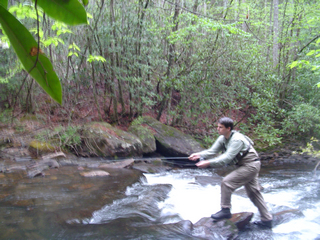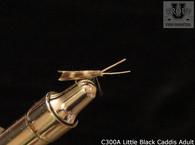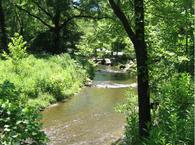
Upon completion of this class the students will have two new types of casts in their arsnel. These casts can be used under some difficult situations perhaps in smaller streams. This class is desinged to increase the students catch per centage in small or difficult streams. However a word of caution: The student should not attempt these casts until they have become proficient in the use of the casting techniques taught in previous classes.
Skip Casts:
IT USUALLY TAKES ME three or four casts to finally put the fly over the fish where I'd like it to land. But I'm a believer in presenting the first few casts to a spot that will be at least a foot or two to my side of the fish. If the fish is really hungry, it'll often charge over to grab the fly. If it doesn't, I can gradually work the fly in closer to the fish's holding spot and get better floats as I adjust the angle of my casting arm and the power of the cast for more dramatic left hooks.
I'll work the bankside run as far as I can with comfortable fifteen- to twenty-five-foot casts upstream and to the left. But before I lengthen my casts I'll try to gradually work the little dry fly in tight to the bank just in case there is a fish that I can't see under the shady willows. Getting a fly under low-hanging willows or any other kind of brush can be almost impossible from my standing position. And it's a good way to lose a lot of flies.
I'm not one who can execute all the fancy "on-my-knees sidearm casts" that I've seen the experts demonstrate to shoot a fly for fifteen feet a few inches above the water. Once in a while, when I'm really on, I can get a fly to skip under the low, overhanging brush by overpowering a low sidearm cast. It takes a little practice to make a skip cast work because you have to aim the fly to hit the water immediately under the overhanging branch with enough sidearm force to cause it to skip back under the brush. The fly actually hits the water behind a short loop of line and leader, which picks up the fly and throws it back under the brush.
To make this work, the casting loop must be in a near horizontal position with the fly trailing lower than the loop. If the angle isn't just right, you'll drive the fly into the water with a hell of a splash of leader and line and scare the fish. It's a little like skipping a flat pebble with a string attached. I'm always afraid the splash the fly makes as it skips back into the dark spaces will spook whatever is in there.
When making a skip cast, I look for a little vertical channel of air between the branches. This isn't an easy cast because the forward line and leader loop must perfectly match the gap in the foliage or you'll catch one of the branches to either side. The slightest breeze can mean trouble. This cast is best made with a rather open loop so that, if the fly does come in contact with a leaf or branch, chances are it'll dribble down to the surface much like a natural that has lost its grip.
If I can't find an open channel between branches, I'll make a few roll casts toward the center of the stream as I gradually sidestep upstream. I move into a position that will allow me to make an across-and-downstream cast to drift the fly downstream under the willow branches, after I've fished the easier water just under the outside edge of the overhanging brush.
I'm always a little surprised that I occasionally get a few strikes out in the middle of the stream with my roll casts. I can spend two hours fishing no more than twenty feet of stream without getting to the other side, where the big trout hang out. The first hour or two spent doing this is a warm-up for what is ahead. I see it as a chance to try a few patterns, net the water to see what I can find, and check out my casting ability. Some days I cast better than other days. And if there are a few little trout rising in a place like this, isn't it a good idea to try to catch them just in case someday a hog is in there? If I'm successful, I'll have a much better chance of fooling the big fish because I know what to do to get a good drift in a tough spot.
My favorite rod for fishing this kind of water happens to be a 8 1/2-foot bamboo with a 5-weight line. It's a 2-piece rod with a butt section strong enough to turn heavy rainbows in whitewater, yet the upper butt and tip are delicate enough to cast eighteen feet of leader with forty inches of 7X tippet and a size 24 dry fly. I think that rods shorter than 8 feet have some built-in handicaps for streams wider than ten or twelve feet. Since mending line seems to be essential in almost every fishing situation I encounter, the longer rod allows me to lift more line from the water to toss an up- or downstream loop to extend drifts. A longer rod allows me to keep my backcast above the willows and other bankside brush, and I can lean a cast to either side of my body.
Lean Casts:
What I call a lean cast comes close to being a reach cast, which is usually made across and slightly up- or downstream by sweeping the rod either right or left just after delivering the forward cast and before the fly lands on the water. This action places the fly line up- or downstream of the main current. I like to think of the reach cast as something I do because I can't or am too lazy to move upstream or down two or three steps. It's a great way to extend a drag-free drift.
I use a lean cast when I've already waded way too deep. To get a proper drift I need to stretch my casting arm far to the right or left as I false-cast (no, I can't cast left-handed) in order to lay the fly line in a section of current that won't drag the fly downstream faster than the current where the fly is. This can often happen when I'm fishing almost straight up- or downstream.
Upstream lean casts are a little easier for hooking a rising trout than downstream casts. In downstream casts the leader tends to straighten way too fast and cause drag, or worse yet, the leader straightens just as the fly comes to a riser. When the fish comes up to suck in the fly, the tightness of the leader prevents it from moving. A good way to stop this from happening is to give the rod a little jiggle as the line is still in the air on the forward cast. The jiggle will produce a bunch of shallow S curves in both the line and leader, which will allow me to strip line from the reel and continue to jiggle the rod as the fly comes within striking range of the fish. The challenge I have in this situation is being able to quickly set up when a fish does take the fly because of all the S curves in the fly line. Since the fly can't move until everything is straight, I try to be careful how big the S curves are.
Another situation that might require a lean cast is when you're behind a boulder and wish to present a fly either upstream or down. The current coming around the boulder will create faster currents that fan away from the boulder for some distance downstream. Study these currents carefully and use the lean cast to get your fly and line to land in the middle of the current.
Note: This class is baed on excerpts from Fly Fishing with AK a Stackpole Books publication.
Assignments, practice, practice and practice with a bit of yarn to act as a fly and remember, be patient.
Continue on to class 4221 for more advanced csts.
Read these books by A. K. Best
Fly Fishing with A. K. Best by Stackpole Books





